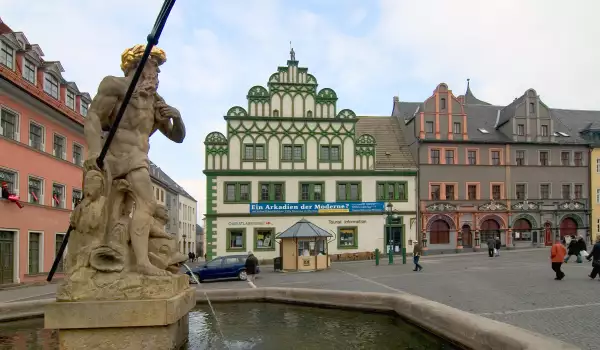Weimar

Weimar is one of the cultural centers of Europe. It is unbelievable how such a small town had such spectacular events that determined the history of mankind for decades and centuries.
Weimar is often known as the German classicism city or town of Goethe and Schiller. These great philosophers were born in Weimar , but on behalf of that spend a significant part of their life in the historic center and die there - Goethe 83 years old and Friedrich Schiller 46. Weimar is associated with the name of a theologian and philosopher, Johann Herder, who developed the ideology of humanism as a philosophical category.

Weimar is located in central Germany, in the picturesque province of Thuringia. At the southern part of the city lies at the foot of the mountain Thüringer Wald, and in Weimar itself flows the river Ilm.
The whole town is situated on an area of 84, 26 sq. km and its population reaches about 65 million inhabitants. Weimar is located 20 km from the town of Jena and the southwest of Leipzig.
The first information about Weimar dates from 899. Over the centuries, the name of the city has undergone a variance - Wimares, Wimari, Wimar and finally Weimar . In 1552, Weimar became the capital of the Duchy of Saxony-Weimar and this lasted until 1918 during the regency of Anna Amalia (1758-1775) and her son Carl August (1809 to 1828 on).
Weimar became an important cultural center of Europe and gave shelter to such luminaries including Goethe, Schiller and Herder, and the virtuoso pianist Hummel, who was a pupil of Mozart.

Weimar was the place of execution of the German intelligents since Goethe first moved toWeimar in the late 18th century. Today, the tombs of Goethe and Schiller, and their records are among the most visited cultural and historical sites in Weimar . After World War I, created there is Germany's new constitution, repealing the monarchy and the Holy Roman Empire. The name Weimar was crucial for the establishment of the Weimar Republic, which lasted for the period from 1919 to 1933
Weimar was the birthplace of the innovative design school, which reversed the minds of Germans after the First World Battle - Bauhaus. History of the Bauhaus began when Walter Gropius, together with a group of artists and designers decided to combine the Weimar School of Arts and the School of Crafts of Henry van de Velde. The aim of the new organization was to launch an innovative design language for the needs of architecture as a whole for the new time after the war.
The efforts of the artists united in the creation of objects that caused both aesthetic enjoyment, and efficiency which can be inexpensively mass produced. The association produces a variety of Bauhaus furniture, pottery and wallpaper. The original school building of the Bauhaus in Weimar today is a university, Bauhaus-University of Weimar , and in the Bauhaus Museum in the city you can see typical examples and articles of furniture in the style of the school. Both buildings are listed as World Heritage by UNESCO.
Among other interesting sights of Weimar are the Conservatory Franz Liszt and the Georg Muhe house, which is a model of his work, as well as the National Theatre of Weimar and the palace Wittumspalais. You can not miss the monument of Goethe and Schiller, which is the emblem of Weimar . The monument symbolizes how two artists stand hand in hand together like common forces. On the southwest of Weimar is located the Belvedere Castle, which was built in 1724.









